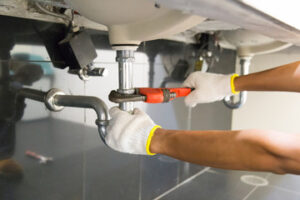Plumbing is a vital part of any building. It brings in freshwater, sends waste away, and keeps things sanitary. Without it, people would have difficulty living in their homes or buildings. For professional help, contact Plumber Shreveport.
Each fixture is connected to a drainpipe via a P- or S-trap (the former uses air; the latter doesn’t). These traps are filled with water so small animals and sewer gas cannot enter.
The sewer and water line in your home are configured a little bit like the branches of a tree. There’s a main line that’s the biggest in size and then smaller lines run off of it, leading to drains in your shower, sinks, bathtubs and floor drains. Unlike clogs that occur in individual toilets and drains, which can usually be cleared by using a plunger or snake, a clog in your main line will likely require professional assistance to resolve.
A clog in the main line can cause sewage to back up into your showers, tubs and sinks. This is because waste and sludge that has been deposited in the line now has nowhere else to go. Foul odors are another clear indication that you may have a clog in the main sewer line.
While preventing the occurrence of a clog in the main line isn’t always possible, taking steps to prevent clogs in other parts of your drainage system is. You can do this by paying attention to your household’s drains and observing how quickly or slowly they work. A slow-draining sink or bathtub might indicate a simple problem, such as a hair clog in the shower drain. However, if you notice this happening in multiple areas of your house, this is likely an indicator that there is a bigger problem.
In addition to the aforementioned clog-causing debris, other common causes of a clogged sewer line include grease, which solidifies as it cools down and sticks to the interior of your pipes; food scraps and kitchen fat that will eventually wash away, but not before it builds up in the lines; and bulky items such as paper towels, so-called flushable wipes and sanitary products that are sent down toilets. Ultimately, the best way to minimize these risks is to dispose of food scraps and other materials in the garbage instead of down the drain.
A clog in the main line is usually a sign that it’s time to call a plumber. These professionals have specialized equipment to diagnose the problem and restore full functionality to your drainage system. They can also recommend ongoing preventative measures that will help to reduce the chances of future clogs.
The impeller is broken
If your pump makes banging noises when it is working they could be a sign that one of the pipes connected to it is loose or cracked. This can cause the pump to swing wildly and make these banging sounds. If this is the case, you should contact a plumber to check and repair it as soon as possible. This can prevent further damage and can save you a lot of money in the long run.
Another sign that your sewage ejector pump is faulty is if it fails to turn on or work properly when the pit is full of water. This is usually due to a damaged or clogged impeller. The impeller is the component that pushes water through the sewage system and should be checked regularly for any issues.
The impeller is a set of blade-shaped vanes that are arranged around a shaft and a magnetic rotor. When the impeller rotates, it sucks in water and gases from the bottom of the pump pit and expels them to the top, creating a flow of clean water. However, this can be interrupted by a number of different problems including a broken impeller, blockage of the impeller chamber or air pockets inside the pump.
One of the most common causes of a faulty impeller is a buildup of debris or mud. To fix this, you can flush and clear the impeller chamber to remove any debris that may be blocking it. It is also important to regularly clean your sump basin and sewage pipe to avoid the buildup of debris.
Alternatively, you can use an impeller puller to remove the impeller and examine it for damage or clogging. This tool can be purchased online or at most hardware stores. However, it is important to note that this procedure requires a fair amount of manual labor and can be very dangerous if you are not careful. You should always wear gloves when handling any tools and be sure to disconnect the power supply to the pump before beginning the process.
It is also recommended that you carry a spare impeller with you on your next boating trip. This way, you can quickly fix any issues with your sewage ejector pump and continue enjoying your vacation.
